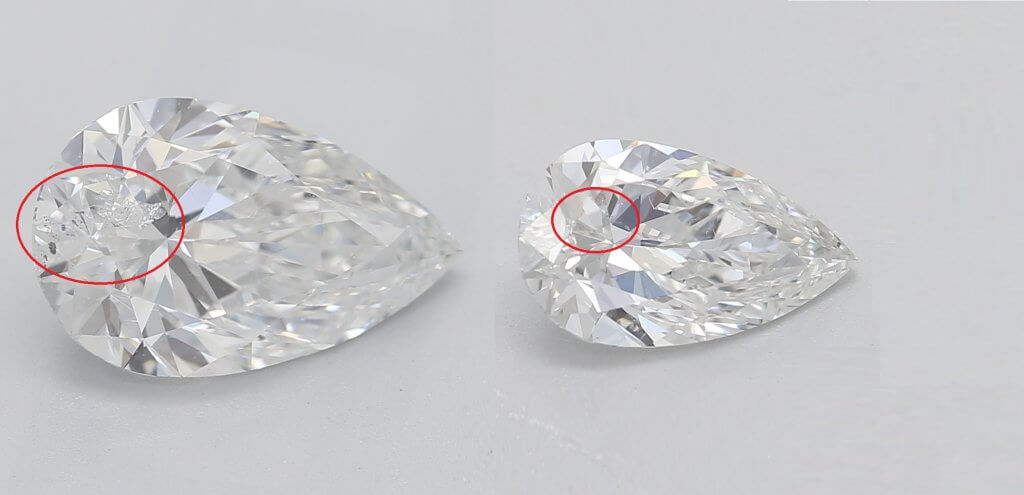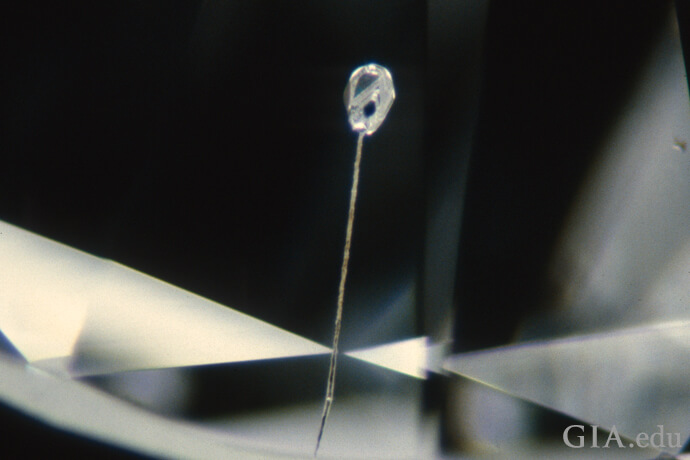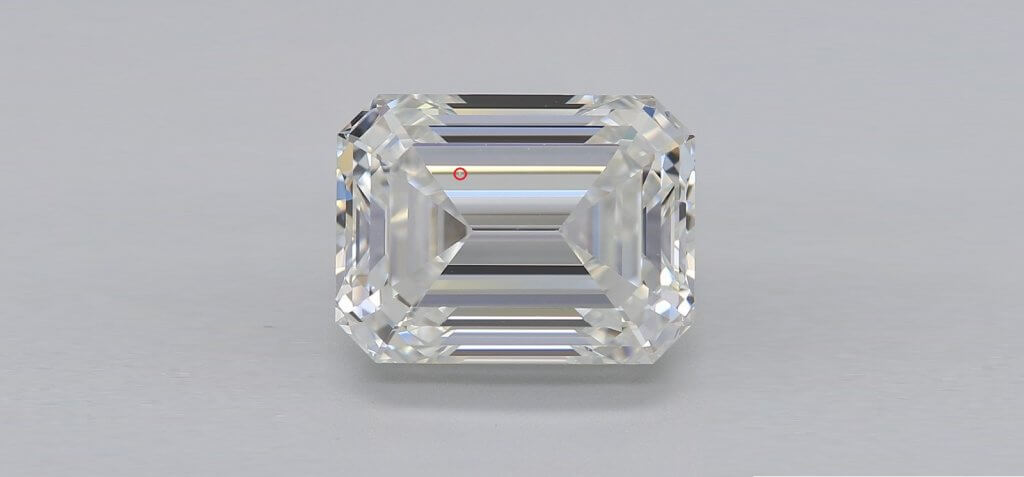Avoiding Diamond Inclusions: The Key To Clarity
Key Takeaways
- The first thing to remember is that inclusions are a natural part of a diamond’s creation.
- They are not necessarily a desirable feature, but they are inevitable and often not significant enough to be noticed by the naked eye.
- It depends on the extent of the inclusion when it comes to actually purchasing an included diamond. For instance, cloudy diamonds are easy to spot and cannot be repaired.
- Avoid any diamond with a visible inclusion – and any diamond with an inclusion located dangerously close to the surface. Inclusions you can’t see, and that don’t pose a risk to the diamond’s strength, aren’t a problem.
- In general, with both of these common inclusions, they should not cause an issue to you unless they are noticeable without a microscope.

Unless we’re focusing all our attention on the subject of clarity, we often talk pretty broadly about inclusions and eye cleanliness, rather than focusing on the different types of inclusions diamonds can feature – and, more specifically, which ones are worse than others.
Inclusions are a natural by-product of a diamond’s creation. They’re inevitable, considering how they’re created, but that doesn’t mean they’re a desirable feature in a diamond destined to be used in fine jewelry – and particularly not an engagement ring. If they’re significant enough to be noticeable to the naked eye, then they’re significant enough to bring down the beauty, value – and maybe even the integrity – of the diamond.
In any GIA report, the majority of a diamond’s inclusions are mapped out on a diagram for the buyer to inspect and compare with what they can see in front of them. It’s incredibly useful, but only if you know how to interpret it, since there’s a very strong chance the ideal diamond for you will feature a number of inclusions of its own.
In other words, you don’t want to be too cut-throat when it comes to ruling out diamonds with inclusions – but you also don’t want to be too cavalier, either…
First Off, Are Included Diamonds Bad?
No. Virtually any diamond sold features inclusions that can be identified under 10x magnification, and it’s far worse to spend thousands of dollars extra on a flawless diamond than it is to invest in an included diamond.
As we mentioned, the diamond you wind up bringing home with you will (hopefully) be included.
Included diamonds are cheaper – a lot cheaper than Flawless (FL) and Internally Flawless (IF) diamonds, which are rare and sought-after by collectors – and, provided you choose a diamond that is not negatively impacted by its own flaws.
Inclusions can interrupt light performance (sparkle), impact the stone’s beauty, or make it a lot more vulnerable to chipping or breaking with regular wear. These are the flaws you should avoid at all costs. But how do you recognize them?
Diamond Chips
Chips are one of the most easy-to-spot – and most unfortunate – inclusions a diamond can have. They are usually caused by wear and tear, either during or after the cutting process, and as a result of a hard knock or impact sustained by one of the more vulnerable parts of the diamond – a sharp corner, or particularly thin girdle or culet, for instance.
A chip will not only show as significant damage to your diamond, but it will also interrupt the stone’s light performance. The placement and size of every facet is integral to the shape’s unique appearance and ability to produce brilliance and fire. Disrupting the shape’s symmetry and facet structure has a much more harmful effect than initially meets the eye, and it’s among the very worst flaws a diamond can have.
How can you identify a chip in a diamond?
A chip will be identified within the GIA diamond plot using the ^ symbol.
Most chips will be obvious to the naked eye, even if they look pretty small without a jeweler’s loupe. You will be able to feel a chip with your finger, too, since it will feel like an irregularity in the diamond’s structure and won’t have the same glassy polish as the rest of the diamonds.
Are Chipped Diamonds Worth Anything?
Chipped diamonds are still sold, but they’re priced a lot lower than others. In terms of holding value for you, we would say no – that there is no value in you investing your money into a diamond that has already sustained appearance-altering damage.
Besides, if a diamond has already chipped once, there’s a high risk it will chip again. If the chip occurred on a fragile girdle, for instance, then what’s to stop another section of the girdle chipping, and leaving you with even less polished diamond? Besides, the edges of any chip will be sharp and fragile, so even a seemingly one-off occurrence could happen again.
Can a chip in a diamond be repaired?
No – a chip can’t be polished away or repaired. A diamond can be re-cut and re-polished but doing so will reduce the size of your diamond quite significantly.
It’s not all that common for people to get diamonds re-cut. It’s typically only considered to be a worthwhile option if the diamond is particularly large, and able to cope with losing a considerable amount of carat weight without losing most of its value.
Sometimes, diamonds hold enough sentimental value that their owners will ask for them to be recut but, often, the best option for a damaged item of jewelry is to have the diamond replaced altogether.
Laser Drilled Diamonds
Despite the fact that almost all diamonds fall below Flawless on the clarity grade scale, it is in no way difficult to find eye clean diamonds. That’s why treated diamonds – natural diamonds that have undergone artificial enhancements to improve color and or clarity – are rarely given much credence by the majority of jewelers, gemologists, and savvy shoppers.
One of the most common treatments for diamonds is known as laser drilling. A very small laser is used to drill a ‘tunnel’ into the diamond until it reaches the inclusion. Sometimes, the laser is enough to remove the inclusion – other times, a corrosive substance like bleach is used to lighten the inclusion.
The drill hole cannot be removed, although it can occasionally be filled with a glassy substance. If not, it can gradually fill with dirt and pollutants and become obvious.
How effective is laser drilling?
Laser drilling has only a minor impact on clarity, and typically raises the grade of a diamond by one or two grades. For most people, it’s just not worth the trade-off.
Techniques for laser drilling included diamonds have grown more and more refined over the years, but laser drilled diamonds are still widely considered to be an inferior choice – and one that should be avoided altogether.
Many jewelers don’t even sell laser drilled diamonds, given how easy it is to find eye clean diamonds that are naturally eye clean.
Theoretically, it is possible to raise a diamond’s clarity grade by much more than one or two grades using laser drilling, but that would require making far more drill holes within the diamond – something that will, eventually, threaten the structural integrity of the stone pretty significantly. Think of a tooth with multiple cavities, and how every additional cavity makes increases its vulnerability more and more.
Does the GIA grade laser drilled diamonds?
Yes, and any laser drill holes will be clearly marked on the diamond plot.
Laser drill holes are identifiable by a small green circle containing a red dot – don’t confuse them with a natural crystal inclusion, which is represented by a hollow red circle.

The overwhelming majority of shoppers do not want to invest money into a laser drilled diamond and knowing how to recognize them within a GIA report is the most reliable method for identifying them – and, of course, avoiding them. It’s not all that common to come across treated diamonds when you’re shopping from reputable stores and vendors, however.
Significant Feather Inclusions
Feather inclusions are among the most common, naturally-occurring diamond inclusions you will encounter, which is why we’ve already written a much more comprehensive guide to diamond feathers.
Unlike the other two inclusions mentioned above, feathers aren’t always dealbreakers. In fact, most of the time they’re perfectly innocuous inclusions that you won’t ever notice or need to worry about.
At times, however, a feather located too close to the diamond’s surface can pose a real problem. Like a crack in a foundation, it can gradually grow more and more significant and put the diamond at a high risk of chipping. If located on the girdle, the risk is particularly high, and the diamond should be avoided in favor of one with the structural integrity to withstand a lifetime in a ring setting.
Many cutters will intentionally avoid inclusions that could threaten the durability of the diamond, but, in some cases, getting the highest possible value from a rough stone means prioritizing size over stealth.
Any diamond’s sparkle is, for the most part, the product of its cut. An excellent cut creates a beautiful light performance, while a low quality cut will lead to a distinct lack of brilliance, fire, and scintillation. Thankfully, this is something most shoppers come to realize before they made the mistake of investing in a cheaper, poorly cut diamond.
The trouble is, the cutter is not always to blame for a diamond suffering from poor light performance. Some diamonds can appear dull and lifeless – with a light performance that makes it resemble a cubic zirconia more than an actual diamond – even if their cut quality meets most shoppers’ expectations.
Cloudy diamonds are caused by widespread crystal inclusions within the diamond. The crystals themselves might not be noticeable without a loupe, but the fact that they are present across a significant portion of the diamond’s internal structure means that light performance is compromised.
Cloudy Diamonds
Some clouds will be represented on your diamond plot by a circle drawn with a dotted line, but others will be noted within the Comments section of the GIA report.
Just like with feathers, minor clouds aren’t necessarily an issue. If you see one drawn on your diamond plot, but can’t see any sign of it in the diamond when you look without a loupe, then it’s unlikely to pose any sort of problem for your diamond, or its light performance.
Usually, a widespread cloud won’t be included in the diamond plot. Instead, the cloud will be noted in the diamond’s additional comments. This is why it is so important that you take in everything printed within the GIA report, rather than just the clarity grade itself. SI2 diamonds, for instance, can be eye clean – and, for that reason, are the ideal grade for getting the best looking diamond for your money – but they can also be visibly included. You can’t rely on the grade alone.
This, coupled with a low clarity grade, will almost always mean that you will be able to see proof of the cloud without magnification or special lighting. The diamond may look beautiful but, under any light source, will emit a sparse sparkle, or appear milky – as though the inside is filled with heavy steam.
In General, Noticeable Inclusions
Crystals, needles, pinpoint inclusions, feathers, clouds and knots are all incredibly common, natural flaws that almost any diamond that has spent the past billion years or so developing and travelling to the earth’s surface will feature. They are a part of every diamond’s story, and it’s a shame for shoppers who believe that they should only spend their money on diamonds with minimal inclusions.
When it comes to maximizing your budget – whatever number you’ve got floating around in your head – we’re huge proponents of included diamonds.
But, at the same time, crystals, needles, pinpoint inclusions, feathers, clouds and knots that don’t require magnification to see are total dealbreakers.
Finding an eye clean diamond is simple and easy, and you don’t need to feel like you’re walking a fine line between a good investment and a terrible investment, just because you’ve made the wise choice of shopping from the lower end of the clarity scale.
Our Summary
When you’re doing your own research and making that ‘mental list’ of things of non-negotiables for your diamond, it’s easy to whittle the entire subject of clarity down to the need for eye cleanliness. This is, of course, the most useful benchmark to use when you’re appraising a potential diamond, but it’s not the complete story.
When you open a diamond’s GIA report – something you must do before you commit to any diamond – the diamond plot is as important a point of reference as the clarity grade, or the diamond itself. You need all three to make a sound decision. While the grade itself offers a great overview of the diamond’s value for money and potential for eye cleanliness, the diamond offers the confirmation you need that it is actually eye clean, and the diamond plot gives you a good idea of any potential weaknesses or unnatural enhancements the diamond suffers from.
Remember that, even as an inexperienced shopper, your own appraisal matters – and that’s why we can’t get behind online vendors who promise to do all the heavy lifting for you. The GIA report was purposefully designed to offer an easy-to-read, transparent guide to shoppers, and your own ability to judge eye cleanliness is as good as anyone else’s, so don’t rule-out the input you can (and should) have during this part of the process.
Included diamonds are the best way to go, whether your budget is right for a 1 carat diamond, a 10 carat diamond, or something a lot smaller, but the diamond plot is always worth your scrutiny before you spend your money.

Jul 18, 2022 By Willyou.net
The Ultimate Guide To VVS1 Diamonds

Mar 26, 2022 By Willyou.net
Discover The Rarity Of Type IIa Diamonds








